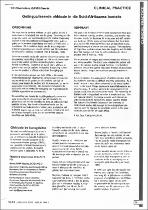| dc.contributor.author | Oberholzer, TG | |
| dc.contributor.author | Geerts, G | |
| dc.date.accessioned | 2022-05-18T06:35:24Z | |
| dc.date.available | 2022-05-18T06:35:24Z | |
| dc.date.issued | 2002 | |
| dc.identifier.citation | 3. Oberholzer TG, Geerts GAVM : Gelingualiseerde okklusie in die Suid-Afrikaanse konteks. J South Afr Dent Assoc, 2002.57;1:25-28. | en_US |
| dc.identifier.uri | http://hdl.handle.net/10566/7415 | |
| dc.description | none | en_US |
| dc.description.abstract | The search for the ideal artificial tooth arrangement that maximizes denture stability, comfort, aesthetics, and function has occupied the dental literature for many years and still continues to do so. Of the many occlusal schemes that have been presented to the dental profession, that of lingualized occlusion has emerged as one of the more popular. The popularity of lingualized occlusion stems from the simplicity and flexibility of the concept and from its wide application to clinical practice (Parr & Ivanhoe, 1996). The registration of a repeatable correct centric jaw relation is not always possible. We don't know whether the patient will use centric relation during normal function. It is therefore useful to provide the patient with some freedom of movement around centric. lingualized occlusion provides freedom in centric. For many dentists the arrangement of artificial denture teeth into balanced occlusion is difficult and time consuming. As a result this task is most often performed by the dental technician. In the South African countryside dental laboratories are often far away. If dentists perform the arrangement of the denture teeth, time and costs can be saved. The mounting of denture teeth in lingualized occlusion is simple and fast. This will motivate dentists to arrange denture teeth themselves, with obvious benefits for both the patient and the dentist. The School of Oral Health Sciences of the University of Stellenbosch teaches this concept to its undergraduate students in order to improve the prosthetic service to the large edentulous population of South Africa. | en_US |
| dc.description.sponsorship | none | en_US |
| dc.language.iso | other | en_US |
| dc.subject | Complete dentures, lingualized occlusion | en_US |
| dc.title | Gelingualiseerde okklusie in die Suid-Afrikaanse konteks. | en_US |
| dc.type | Article | en_US |

